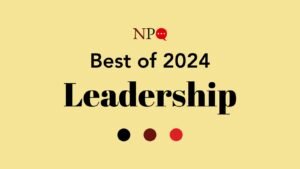
Navigating social identity, or the various attributes and beliefs that make us different from others, can be tricky in the nonprofit workplace, but doing so is critical to leading effectively. As part of a leadership development training that Community Resource Exchange (CRE) conducts with nonprofit managers called the High Performing Managers Initiative, we recently invited more than 40 emerging leaders to reflect on the question of how identity matters to their leadership. Several themes emerged that serve as a lesson to all of those in leadership at nonprofits.
- Identity is inextricably linked to power and privilege: Through experiential exercises, participants shared how aspects of their own identity often became noticeable to them through an experience of otherness. Identities they took for granted were often part of their own privilege. Awareness of the power and privilege—or lack thereof—that comes with possessing multiple identities is an important foundation for cultivating self-awareness as a leader.
- Adapting comes at a cost: Participants who have race or class identities that are different from the dominant norm of their workplace spoke about the burden of code-switching, or adapting to the expectations of the organizational culture’s dominant norms. They identified the feeling of being an “outsider” as taking a toll on their ability to bring their full, authentic personality to work. This was also cited as a common reason people of color are overlooked for promotions or choose to opt out of an organization’s leadership paths.
- Marginal identities can be a strength: At the same time, several participants said having a marginalized identity fostered connections with others. Being from a socioeconomically disadvantaged background, for example, helped participants to more clearly see injustice and connect with clients that had shared experiences. It also helped participants use their life stories as examples of success for these communities.
- Acknowledging difference and privilege can builds bridges: Participants shared insights about building camaraderie with someone who holds a dominant identity—such as being white—which can often stay invisible. One participant who managed a multiracial team shared how acknowledging her privilege as a white woman—and naming whiteness as part of her identity—was an important starting point for building connection and trust. Her acknowledgement helped create a space where it was acceptable to talk about race and how it impacted the team and their work clients.
Here are three strategies that can form a great foundation for navigating identity as a nonprofit leader:
1. Cultivate identity awareness and cultural literacy: Consider what identities are most salient to you, and why. These are likely to shape your worldviews, relationships, and decisions, and can show up in all of us as implicit bias. Recognizing and being able to speak about the pain, power, and pertinence of identity for you, your colleagues, and your clients will enable you to lead more effectively in complex situations where input from multiple, often contradictory, perspectives is required.
2. Be thoughtful when seeking authenticity: We tend to laud authentic leadership as the ultimate goal without fully considering the challenges this involves for the individuals who have to adapt themselves or render invisible core elements of their personality in order to survive in dominant cultures.
There are no easy answers to this bind. For those with marginalized identities: Identify your non-negotiables where it relates to organizational culture. Seek relationships at work that affirm your identities. Build diverse alliances that can help you advocate for more inclusive organizational norms. Expand authenticity by recognizing the pain and triggers that arise from some of your identities. Also, practice self-care to process and manage the emotions—often anger or rage—that you may be expressing in ways that are less constructive for you, your team and your clients.
Sign up for our free newsletters
Subscribe to NPQ's newsletters to have our top stories delivered directly to your inbox.
By signing up, you agree to our privacy policy and terms of use, and to receive messages from NPQ and our partners.
For those with dominant identities, ask yourself, how do I exert or share power in interactions with colleagues and clients? How do I benefit from inequity? How can I create leadership pathways to allow everyone to reach their potential? These questions offer a starting point for redefining authentic leadership as something that builds trust with—and accountability to—those we want to serve. That will lead to being an effective advocate for equity and change both within the organization and externally.
3. Be courageous: Courageous leadership means being attuned to the interpersonal and organizational dynamics of identity. This can mean engaging in difficult conversations around race, gender, and other identities; naming microaggressions when they arise; and using your position of authority to promote organizational dialogue and learning. Be attentive to who has a voice in your organization. Where possible, seek out and center marginalized voices. Share power and enable diverse leadership.
Navigating identity can be challenging, but it is ultimately a worthwhile and necessary practice. Identity matters in life, at work, and in leadership—whether we acknowledge it or not. The African American poet, scholar, and activist Audre Lorde famously said, “It is not our differences that divide us. It is our inability to recognize, accept and celebrate those differences.”
This article was published in its original form by NYN Media and written by Community Resource Exchange.
Fiona Kanagasingam is director of consulting for talent management and innovation at Community Resource Exchange. Yassi J. Tamdji is CRE’s project manager for leadership and professional development.









